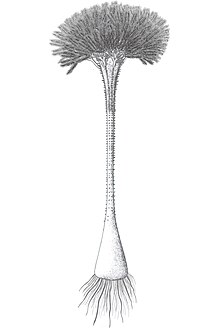| Calamophyton Temporal range: Middle Devonian
| |
|---|---|

| |
| Scientific classification | |
| Kingdom: | Plantae |
| Clade: | Tracheophytes |
| Division: | Pteridophyta (?) |
| Class: | †Cladoxylopsida |
| Order: | †Pseudosporochnales |
| Family: | †Hyeniaceae |
| Genus: | †Calamophyton R.Kräusel & H.Weyland, 1925 |
| Species | |
| |
Calamophyton is an extinct genus of tree, or "tree-sized plant",[1] that was extant in the Middle Devonian period. Calamophyton trees formed the earliest known forests.[2]
Discovery
The genus was established in 1926 from specimens collected by R. Kräusel & H. Weyland, in Hardberg and Kirberg, Rhineland, Germany, who identified the type species C. primaevum.[3] A second species, C. renierii, was identified by S. Leclercq in Belgium in 1940, a third, C. bicephalum, also in Belgium, by Leclerqc and H. Andrews in 1960,[3] and a fourth, C. forbesii, in the Mapleton Sandstone, Maine, United States, by James M. Schopf in 1964.[4] It has since been suggested that C. primaevum and C. bicephalum may be the same species. All samples date to the Middle Devonian.
Description
The genus has been described as having an unusual morphology. Specimens are between 0.8 and 4 metres in height. The trunks, which were hollow, were comprised of multiple interconnected vertical strands of wood-like material known as xylem.[5] As the xylem grew in diameter, they would split apart from one another near the top of the tree, thus limiting the overall height.[5][6] Branches grew only at the top; as the trunk grew, the lower branches would be shed, creating a thick carpet of twigs on the ground below, supporting further biodiversity. The branches did not have leaves, but rather "twig-like structures" that performed photosynthesis. Camalophyton reproduced not by seeds like modern trees, but via spores.
Earliest known fossil forest
In March 2024, paleontologists revealed the discovery of the earliest-known fossilized forest, comprised of Calamophyton trees, in the Hangman Sandstone Formation at Minehead, Somerset, England. In the Middle Devonian period when the forest was formed, this region would have been adjacent to Germany and Belgium. The fossilized forest, at an age of 390 million years, pre-dates the previously oldest-known example, a root system discovered in New York State, by about four million years.[7]
According to one of the involved scientists, Dr. Christopher Berry, the unprecedented preservation of the newly-discovered forest allows researchers to see "for the first time, these trees in the positions where they grew", thus providing the "first opportunity to look directly at the ecology of this earliest type of forest, to interpret the environment in which Calamophyton trees were growing, and to evaluate their impact on the sedimentary system."
References
- ^ Giesen, Peter; Berry, Christopher M. "Reconstruction and Growth of the Early Tree Calamophyton (Pseudosporochnales, Cladoxylopsida) Based on Exceptionally Complete Specimens from Lindlar, Germany (Mid-Devonian): Organic Connection of Calamophyton Branches and Duisbergia Trunks". The University of Chicago Press Journals. University of Chicago. doi:10.1086/669913. Retrieved 17 March 2024.
- ^ Devlin, Hannah (7 March 2024). "World's oldest fossilised trees discovered along Devon and Somerset coast". The Guardian. Guardian News & Media Limited. Retrieved 17 March 2024.
- ^ a b Leclercq, Suzanne; Andrews, Henry N. Jr. (Feb 1960). "Calamophyton bicephalum, a New Species from the Middle Devonian of Belgium". Annals of the Missouri Botanical Garden. 47 (1): 2. doi:10.2307/2394614.
- ^ Kasper, Andrew E. Jr; Gensel, Patricia G.; Forbes, William H.; Andrews, Henry N. Jr. "Plant Paleontology in the State of Maine - A Review". digitalmaine.com. Maine Geological Survey. Retrieved 18 March 2024.
- ^ a b "World's oldest and most complex trees". www.cardiff.ac.uk. Cardiff University. 23 October 2017. Retrieved 18 March 2024.
- ^ Irving, Michael (13 March 2024). "Strange trees in world's oldest forest ripped themselves apart to grow". New Atlas. Retrieved 18 March 2024.
- ^ Barras, Colin (19 December 2019). "Scientists have discovered the world's oldest forest—and its radical impact on life". Science. American Association for the Advancement of Science. Retrieved 18 March 2024.